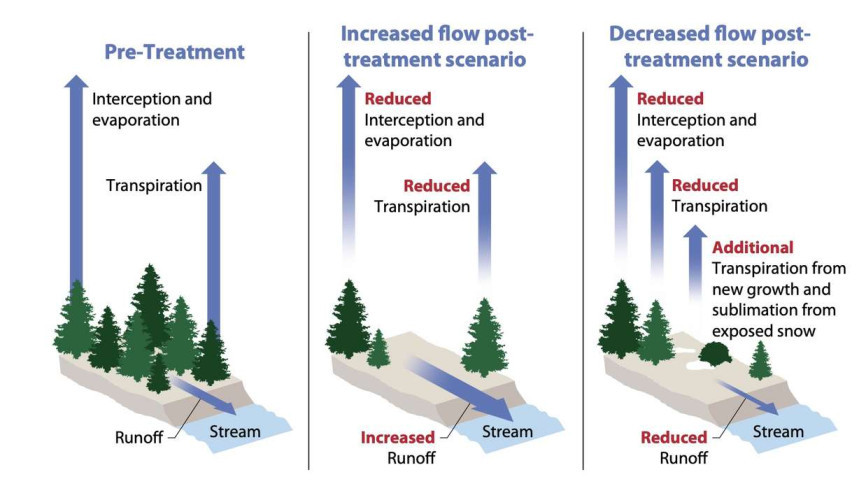SALT LAKE CITY — A new report compiled by dozens of Utah researchers suggests that thinning overgrown forests within the Great Salt Lake basin won't significantly impact the lake's water levels as much as proponents of the idea believe.
Their findings, released Wednesday, back what other experts told the Salt Lake County Council on Tuesday, as the county — and state — considers the option as a potential solution to water issues amid the state's ongoing drought.
The benefit of thinning forests is "unclear" but also "likely to be minimal" when it comes to getting water to the Great Salt Lake, the Great Salt Lake Strike Team, a large group of Utah departments and research institutions, wrote in a report issued Wednesday. It lists options like agriculture optimization or temporarily leasing water rights as more practical solutions at the moment.
"There have been proposals proposed really over the last month, where they say 'if you cut down as many trees as you can, we will have a concurrent increase in water flow. The science is by far more nuanced on that," said Brian Steed, the director of the Janet Quinney Lawson Institute for Land, Water, and Air at Utah State University, and one of the report's many authors.
"While there have been instances where we can see that to be the case, I would not go to the bank to say that's the way," he added.
Thinning forests and water
Several local and state leaders have supported the idea of thinning the forest as a solution for the Great Salt Lake.
One of those is Salt Lake County Councilwoman Dea Theodore, who asserted during a meeting last week that trees in the overgrown forest and other nonnative trees along the county's rivers and streams "are consuming trillions of gallons of water that would otherwise flow downstream to the Great Salt Lake."
But regional ecology is a major factor for success, says Brian Brown, a master's student in environmental science at Brigham Young University. He and Ben Abbott, an assistant professor of ecosystem ecology at BYU, were invited by the Salt Lake County Council to speak about the subject to members of the council during a work session this week.
Brown contends that, yes, there is research that shows thinning forests can lead to more runoff but most of the studies were conducted in "systems with lots of available water," such as the East Coast. However, similar research in the West has produced a mixed bag of results, mostly because removing trees has the potential to speed up the evaporation process on a mountainside in the region.
"In some of these forests, there is more water than the sun can evaporate during the season. We're in the opposite condition. There is an abundance of solar energy coming into the system to evaporate all the water with or without trees," Abbott added, noting that trees in the Great Basin can slow down this process.

This graphic shows the current runoff system in the Great Salt Lake basin with possible outcomes to stream flow from forest-thinning projects. (Photo: Great Salt Lake Strike Team)
That's what the strike team report acknowledges. David Tarboton, the director of USU's Utah Water Research Laboratory, explained Wednesday that the team's finding is the result of analyzing about 150 watersheds, where thinning forests helped in some places but hurt streamflow in other areas. They found success often depends on slope angles, aspect, elevation and tree species.
The team ultimately determined that there could be "modest additional runoff" by thinning the forest but there also is "the potential to backfire and decrease streamflow."
Brown points out that BYU's research on the matter was conducted differently from USU's but both studies reached a very similar conclusion.
"There's very little empirical evidence that forest disturbances that remove significant portions of the trees actually cause an increase in flow leading to the rivers and the lake," he said.
Where forest thinning is more impactful
The strike team report — and other experts — point out there are still significant benefits to forest management, though. Thinning forests can improve forest health and reduce the risk of major wildfires, which can have the potential to seriously impact water in the Great Salt Lake basin.
A large wildfire in Salt Lake County's mountains, for example, could result in a "very negative impact" on water quantity and quality for the communities in the watershed basin, says Laura Briefer, the director of the Salt Lake City Department of Public Utilities.
It's a real threat, adds Bekee Hotze, the Salt Lake district ranger of the U.S. Forest Service, which is why the agency is spending $18.25 million on forest management in the Wasatch landscapes of the Uinta-Wasatch-Cache National Forest in the 2023 fiscal year. This work would be more strategic toward fire prevention and less about water supply, as some trees could be replanted.
The project calls for prescribed fires and "creating or strengthening" fire lines. The forest service plans to treat at least 105,000 acres of overgrown forest land over the next seven to 10 years in an effort to reduce wildfire risks along the Wasatch Front and Tooele County's watersheds.
About another $24 million will be provided next year. Hotze added that the agency is working with partners to get the work done because it doesn't have enough resources to do it alone.
"There's a lot of work to do," she added, noting that invasive beetle species are killing off large quantities of subalpine firs in the basin that will need to be removed. "When we leave those trees dead and down, that becomes hosts for some of those pests."
These types of projects once received backlash. Briefer said there was "pretty significant" public opposition to a project in City Creek Canyon a few years ago. This also stopped similar projects from happening in other parts of the forest, Hotze admits.
However, that's started to change because of how devastating wildfires have become in other parts of the West. The goal is to prevent that and any severe damage to the region's water supply.
"People have a lot more awareness of the need to manage forests," Briefer said. "It's not just simply cutting down a tree for the sake of cutting down a tree. There's a lot of science, there's a lot of strategy behind it and really, in the long run, (it) will make much-healthier ecology for us."








